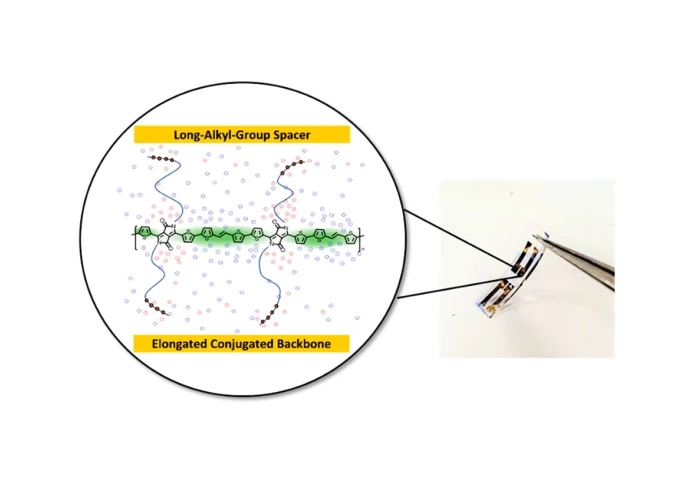A new material strategy for efficient bioelectronics


Researchers demonstrate a new material design strategy for higher performing organic electrochemical transistors.
Bioelectronics is an emerging next generation technology that bridges the gap between biological systems and electronics. Healthcare is being revolutionized with practical applications like wearable and implantable devices that are flexible, lightweight and low-cost for body signal monitoring, drug delivery systems and more.
A key component in bioelectronics is the organic electrochemical transistor, because the active material is able to conduct and transduce both biological (ionic) and electronic signals. It is also important to use materials capable of low-voltage operation (< 1V) so that there are no detrimental effects on biological systems. Accumulation-mode materials are promising candidates that benefit from being insulating until a low voltage is applied. The chemical structure of the materials is also easily controlled, which is advantageous in tailoring the materials’ performance and stability to suit the bioelectronic application. Most accumulation-mode materials are modified with polar groups on the sidechains to enable swelling and ion conduction in aqueous media. However, this typically causes undesirable effects on the materials’ electronic conduction and film structure.
Researchers from the Centre for Processable Electronics at Imperial College London have demonstrated a new material design strategy for higher performing and stable accumulation-mode organic electrochemical transistors. The ionic conduction of the compound is greatly enhanced without reducing its electronic conduction by simply adding a long non-polar group onto the polar sidechain, called a long-alkyl-group spacer. With a longer donor unit in the main structural backbone, this results in a better film morphology for faster electronic current. Through the combination of the two material designs, they demonstrate spatial control of ion-structure interactions to reduce adverse structural changes and maximise device performance and stability. By broadening the toolkit for the development of efficient electrochemical organic transistors, this study potentially opens up a new class of bioelectronic devices.
‘The Role of Long?Alkyl?Group Spacers in Glycolated Copolymers for High?Performance Organic Electrochemical Transistors‘ by Ellasia Tan, Jingwan Kim, Katherine Stewart, Charalampos Pitsalidis, Sooncheol Kwon,Nicholas Siemons, Jehan Kim, Yifei Jiang, Jarvist M. Frost, Drew Pearce, James E. Tyrrell, Jenny Nelson, Roisin M. Owens, Yun-Hi Kim, Ji-Seon Kim is published in Advanced Materials.
Publication link: https://doi.org/10.1002/adma.202202574
Article text (excluding photos or graphics) © Imperial College London.
Photos and graphics subject to third party copyright used with permission or © Imperial College London.